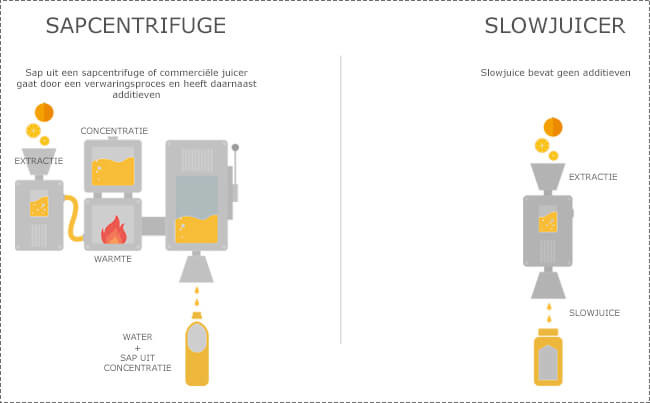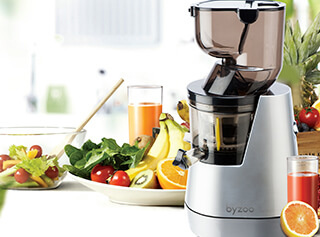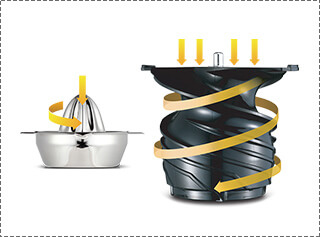Slow juicer, Juicer of Blender?
The only press suitable for wheatgrass and other leafy vegetables and herbs
A slow juicer is the only juicer that can make wheatgrass juice thanks to the slow, crushing pressing. Juicers and blenders grind the grass into small, indigestible particles. With a slow juicer you prepare 100% pulp-free wheatgrass juice. Other leafy vegetables and herbs, such as spinach, lettuce or mint, can also be pressed exclusively with a slow juicer. Click here for more information about wheatgrass.
What is the difference between a slow juicer, juicer and blender?
A traditional juicer uses a sharp grater that rotates at a very high speed (up to 20,000 revolutions per minute). Oxygen mixes in the juice, causing it to oxidize within minutes. You can recognize this process by the discoloration and the separation of solid and liquid parts in the juice. In addition, heat is released at the molecular level due to the high speed of juicers. Enzymes, but also vitamins and antioxidants are sensitive to temperature. These are therefore lost in a juicer. A slow juicer does not have these disadvantages. A slow juicer squeezes at a low speed (an average of 70 revolutions per minute), so that no oxygen enters the juice and the temperature is low. As a result, the nutrients of the products are optimally retained.

In a blender, oxygen is beaten into the juice. Vitamins and some minerals react with oxygen. This process is called oxidation. Vitamins are therefore lost. In particular, vitamins that act as an antioxidant are sensitive to oxygen. These are mainly vitamins A and C in fruits and vegetables. The reason that these two vitamins are (partly) lost in a blender probably has to do with the oxygen that mixes in the juice. Always make sure that the time of mixing the juice in the blender is as short as possible. The time of blending seems to have a major impact on the vitamins in the juice, according to the Australian Government National Measurement Institute study. The longer the time of blending, the more nutrients are lost. The reason for this is that the chances of getting oxygen into the juice are likely to be higher. This ensures a lower nutritional value.
Therefore, always choose a good blender with high-quality blades. As a result, nutrients are processed less coarsely, so that they are better preserved. In addition, the time of blending is also shorter when strong and sharp knives are used, because juice is made from the pieces of fruit and vegetables in a shorter time. With lower quality knives, the time of blending becomes longer and more nutrients are lost.
A plus of a blender is that fiber does get into the juice because the entire product is used. Fiber is good for our health. They ensure good intestinal function and healthy digestion. In addition, fiber gives a saturated feeling, so that less is eaten and therefore fewer calories come in. The amount of fiber from a smoothie is a relatively small addition to the recommended daily amount of fiber. Always see smoothies and juices as a healthy addition to your diet.


Choose a slow juicer for the best quality fruit and vegetable juices. For more information, see this website. If you have any questions, you can reach us at telephone number 035-6910253 or via [email protected].

